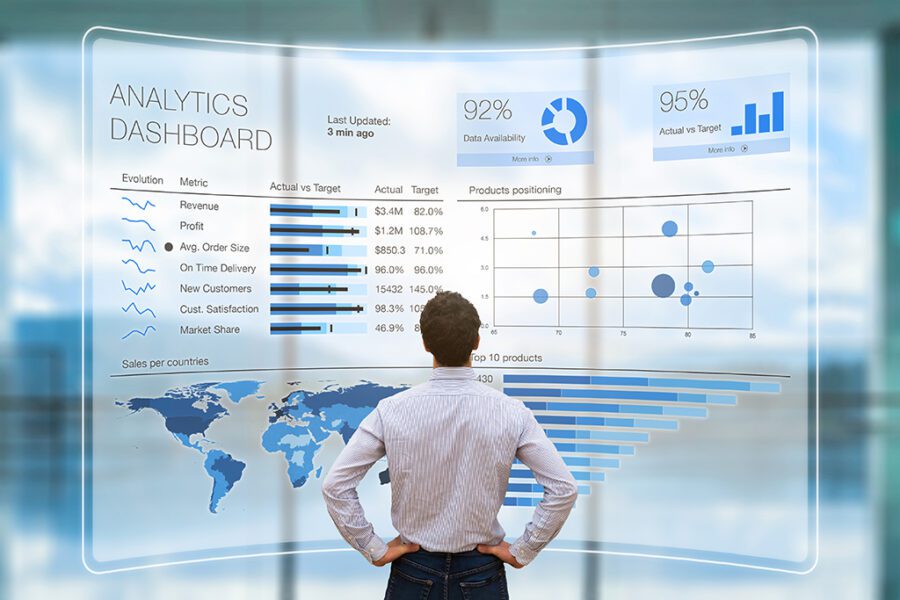Data is the biggest resource in modern day business. It can make or break an organisation. To maximize the potential of data, businesses use powerful tools such as Power BI and Microsoft Fabric. These platforms are the linchpins of business intelligence. And when integrated with Azure Data Factory, they can be a force that is unstoppable in data analytics and decision-making.
Power BI: Your Business Intelligence Companion
Power BI by Microsoft is an effective business intelligence program that lets businesses visualize and share their data. It allows users to create interactive dashboards and report, transforming raw information into useful information.

No matter if you’re a tiny startup or a major company, Power BI adapts to your needs. It is able to seamlessly integrate with various data sources that make it simpler to merge data from several systems and databases. The user-friendly drag-and-drop interface makes it possible for even non-technical users to create useful reports.
The Power BI platform supports real-time data processing, ensuring that you’re always working with most recent data. Power BI offers a range of visualisations that permit you to present information in a comprehensible, appealing manner. Sharing reports and collaboration with coworkers improves decision-making and promotes a data driven environment within your company.
Microsoft Fabric The weaving of data Excel
Microsoft Fabric is an underpinning framework which connects and manages the data gathered from different Microsoft services. It’s the fabric that weaves your data into one functional entity that allows organizations to draw insights effortlessly.
With businesses dealing with ever-increasing the volume of data they have to manage, Microsoft Fabric provides the foundation for data consistency and integrity. Microsoft Fabric can be integrated with a range of applications from Azure Data Lake Storage, Azure SQL Data Warehouse and Power BI. This connectivity ensures that information is flowing smoothly and that information can be derived from a variety of sources.
Microsoft Fabric excels at data transformation. Utilize it to tidy up and prepare data for analysis. You can also use it to ensure that your data is compliant to your organization’s guidelines on data governance. Microsoft Fabric is the platform that will ensure your data is reliable as well as accurate and prepared for analysis.
Azure Data Factory: the Gateway to Data Transformation
Azure Data Factory is another essential component in the modern business intelligence landscape. It’s a cloud-based data integration service that allows you to set up, schedule and control data-driven workflows. Azure Data Factory allows for meaningful insights by orchestrating the transformation of data and its movement.
One of the key strengths of Azure Data Factory is its ability to connecting to various data sources. Your data is able to be integrated effortlessly, whether on-premises, cloud-based or both. This will give you complete visibility of the entire ecosystem regardless of where the data is located. The platform can handle batch processing, real-time streams of data and big data analytics. This is why it is suitable for all kinds of use cases.
Azure Data Factory offers a visual interface that facilitates the design of data pipelines. You don’t need to be an expert in programming to develop, schedule, or monitor workflows in data. This software lets businesses manage their data integration processes and allows them to prepare data themselves.
Power BI, Microsoft Fabric and Azure Data Factory: The Power Trio
If Power BI and Azure Data Factory when combined and merged, they form an impressive trio that can change the way you analyze data. The way they work together:
1. Data Integration: Azure Data Factory is able to connect with a variety of data sources. This makes sure that all your data is accessible. This capability for data integration feeds Microsoft Fabric which orchestrates data across a variety of services. It ensures that your data are properly structured, cleaned and is ready for analysis in Power BI.
2. Microsoft Fabric’s Data Transformation function is vital to satisfy your analytical requirements. Fabric is a powerful tool for data transformation as well as data cleansing and manipulation.
3. Power BI is able to perform the task after your data is analyzed and refined. You can design visually appealing reports and dashboards that make the data easier to understand. You can then share these data with your colleagues, to encourage data-driven decision-making.
4. Scalability: Azure Data Factory scales effortlessly to handle increasing amounts of data. Additionally, the power of Power BI and Microsoft Fabric ensures that your data remains steady and reliable as your business expands.
5. Real-time insights: With real-time data processing capabilities, Power BI and Azure Data Factory provide up-to-the-minute insights that can be critical for a quick decision-making process.
Also, you can read our conclusion.
Business intelligence is evolving rapidly and organizations must harness the power of data to stay ahead. Power BI combined with Microsoft Fabric and Azure Data Factory can take your business analytics to a new level. These three components can help you achieve amazing visualizations, improve data consistency and speed up processes. Explore the full potential of data using business intelligence.